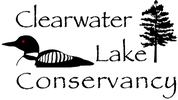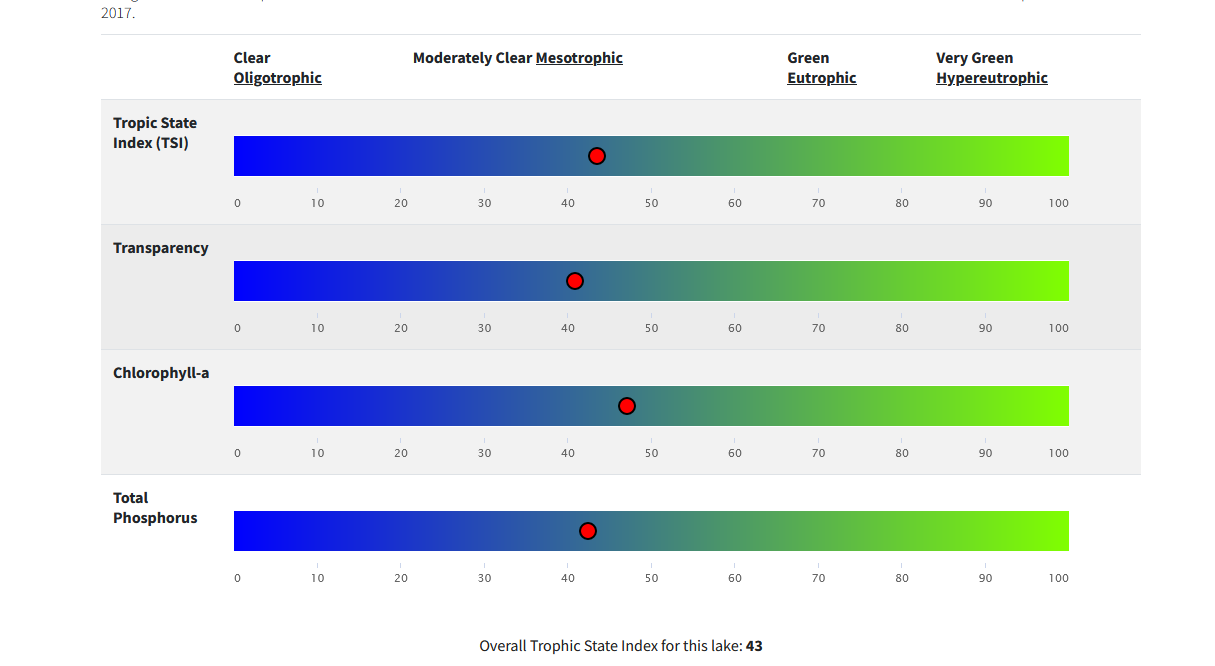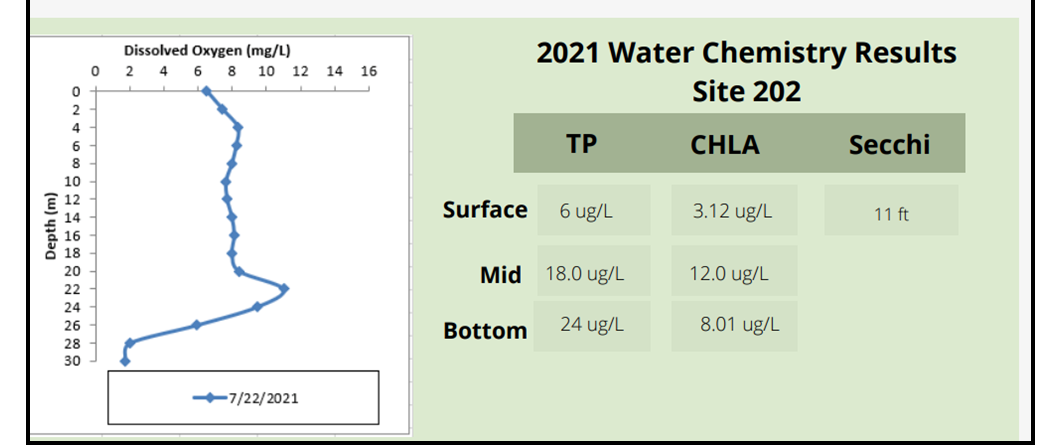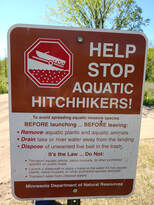|
What is TSITrophic State Index (TSI)
There are 3 measurements that are tracked regarding lake health; phosphorus (nutrients), chlorophyll A (algae concentration) and Secchi depth (transparency). They are related to each other. As phosphorus increases, there is more food available for algae, resulting in increased algal concentrations. When algal concentrations increase, the water becomes less transparent and the Secchi depth decreases. The results from these three measurements cover different units and ranges and thus cannot be directly compared to each other or averaged. In order to standardize these three measurements, we convert them to a trophic state index (TSI).
The mean TSI for Clearwater Lake falls in the mesotrophic range. Mesotrophic lakes (TSI 40 ‐ 50) are characterized by moderately clear water most of the summer. "Meso" means middle or mid; therefore, mesotrophic means a medium amount of productivity. Mesotrophic lakes are commonly found in central Minnesota and have clear water with algal blooms in late summer. Phosphorus
Clearwater Lake is phosphorus limited, which means that algae and aquatic plant growth is dependent upon available phosphorus. Total phosphorus was evaluated in Clearwater Lake in 2007 ‐ 2008. The data does not indicate much seasonal variability. The majority of the data points fall into the mesotrophic range.
Chlorophyll A
Chlorophyll A is the pigment that makes plants and algae green. Chlorophyll a is tested in lakes to determine the algae concentration or how "green" the water is. Chlorophyll a was evaluated in Clearwater Lake in 2007 ‐ 2008. Chlorophyll a concentrations for all dates except one remained below 10 ug/L, indicating clear water most of the summer.
Transparency (Secchi Depth)
Transparency is how easily light can pass through a substance. In lakes, it is how deep sunlight penetrates through the water. Plants and algae need sunlight to grow, so they are only able to grow in areas of lakes where the sun penetrates. Water transparency depends on the amount of particles in the water. An increase in particulates results in a decrease in transparency.
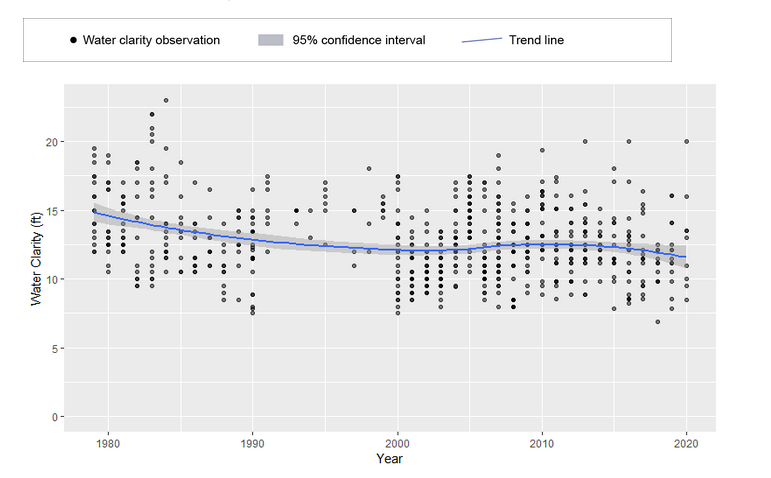 Click to Enlarge - Image from MN Pollution Control Click to Enlarge - Image from MN Pollution Control
The mean transparency for Clearwater Lake ranges from 10.2 to 15.4 feet. Overall, Clearwater Lake shows no detectable trend in transparency, meaning that transparency is stable.
MN DNR: For years 1979 to 2022 there is evidence of no change in water clarity at this lake. For the most recent year of the analysis, median water clarity was 2.90 feet higher than the watershed median. 2021 Clearwater Lake IndexReview of Clearwater Lake 2021 TSI values by Freshwater Scientific Services
(1) What each number means: – TP is total phosphorus and indicates how fertile your lake is – CHLA is chlorophyll-a and indicates how much algae is in the water (more algae = more chlorophyll) – Secchi is water clarity All three of these are closely related; more fertile lakes usually have more algae, and more algae leads to lower water clarity. To be listed as impaired, a lake like your would need to have a mean summer TP concentration of 30 µg/l (surface sample - not from bottom of lake). Your lake was at 6 µg/L in 2021. Phenomenal! (2) Trend in Secchi data?: The plot appears to show a decrease in clarity from the 1980s to today, but without digging into the past data, it is difficult to say whether this is a real trend. This data set was collected by lake-volunteers. Some sources of error could be differences in surveyors, time of day that secchi was recorded, and what dates are included in the annual averages – if early spring and late fall data are included, tend to get bigger averages than if only summer data are included. (3) What about the higher TP and Chl-a in deeper samples? After your lake stratifies, it loses oxygen in the bottom layer (very common in MN lakes). Under lower oxygen conditions, phosphorus can be released from the sediment in deep parts of the lake. This released phosphorus builds up in the lower lake layer, but only leads to algae growth if it gets stirred up into the surface layers. Looking at how deep the thermocline was in your lake, there was very little potential for such mixing until the lake turned over in the fall. Compared to the TP and CHLA levels that I see in most of the lakes in MN, Clearwater is much lower - really excellent! (4) Oxygen Levels: There are no signs of any problems with oxygen in your lake. The drop in oxygen near the bottom is very normal and is due to strong lake stratification. Again, your lake looks great in terms of oxygen! James A. Johnson Aquatic Ecologist; MS, CLM fixmylake.com Secchi Data for Clearwater Lake in ReviewThe Secchi data provided in the RMB water quality report is being reviewed. The value of 11 feet does not reflect the numbers provided by our volunteers. When we have a better understanding of the discrepancy we will update the information.
The secchi data can be viewed on the MN pollution control agency web page www.pca.state.mn.us. If you want to find out more information search by our lake id 18-0038-00. Here is a direct link to our lake. The data posted as of 12/8/21 the 2021 values are not posted yet. |
